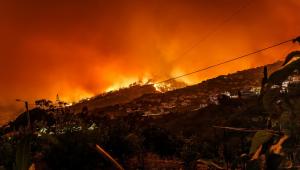
Wildfire Recovery: Essential Health and Air Quality Precautions During a Crisis
“The aftermath of a wildfire brings challenges, especially regarding health concerns due to lingering smoke and ash. As wildfires badly impact the air quality, it’s crucial for individuals and communities to stay protected. Therefore, access to reliable and safe information is necessary to help individuals take informed actions for recovery,” stated Achim Haug, the CEO and Founder of AirGradient.
While we recognize that inhaling smoke is dangerous, the hazard level depends significantly on the source. Wildfire smoke is particularly hazardous compared to other types of smoke, such as from cooking or traffic, as it contains a toxic mixture of gases, chemicals, and fine particles from burning trees, shrubs, buildings, and vehicles. The diversity of materials consumed in wildfires dramatically increases the smoke’s toxicity, making it one of the most dangerous forms of air pollution.
Wildfire smoke inhalation can have both short-term and long-term health effects, impacting people of all ages and health conditions. Some of the effects include:
Short-term effects: Eye, throat, and lung irritation, coughing, wheezing, trouble breathing, increased heart rates, risk of heart attacks, headaches, dizziness, and fatigue.
Long-term effects: Lung diseases like asthma and Chronic Obstructive Pulmonary Disease (COPD), heart disease and stroke, and the potential development of certain types of cancer. Continuous exposure can also weaken the immune system, making it harder for the body to fight infections.
How to Stay Safe After The Wildfires
As individuals return home, it’s crucial to prioritize safety and stay informed. Here are essentials to protect against the lingering effects of wildfire:
Use Proper Masks: The lingering smell of smoke and burn is a common aftermath of wildfires. Always be prepared with proper masks, such as N95 or P100 respirators, which help protect against harmful particles, especially outdoors or in areas with compromised air quality.
Utilize Air Purifiers: If staying indoors, use HEPA-based air purifiers to minimize smoke exposure. Air purifiers with HEPA filters can effectively remove fine particles in the air, such as allergens, dust, smoke, and chemical compounds. Place the air purifiers in the most-used areas for maximum protection.
Check for Hidden Hazards: When returning to the property, be cautious of hotspots, fallen power lines, and damaged structures. Wear protective gear, including gloves and boots, when cleaning up debris to avoid injury or exposure to toxic materials.
Monitor Air Quality: Lingering smoke can persist for days or weeks, especially without significant weather events like rain or substantial winds. Regularly monitor local air quality for indoor and outdoor environments to determine when it’s safe to be outdoors.
Understanding Key Air Quality Indicators
When checking the air quality by using an air quality monitor, it’s essential to focus on the key indicator, as many monitors also record levels of other pollutants such as SO2 and NOx. The levels of CO2 and PM 2.5 are critical in assessing indoor and outdoor air quality. Various guidelines exist for acceptable levels of CO2 and PM 2.5. The World Health Organization recommends that the average concentration of PM 2.5 particles should not exceed 15 micrograms per cubic meter (µg/m3) over 24 hours, a standard also followed by AirGradient. For CO2, AirGradient considers that levels below 801 ppm indicate safe and excellent air quality.
To further provide geographical context, AirGradient recently delivered a global and real-time air quality map that allows individuals and communities to monitor air quality in specific areas. This map is accessible for free, and no subscription is needed. It can help instantly identify the level of CO2 and PM 2.5, ensuring timely and informed decisions about safety.
Yohana Angeline
Airgradient Limited
+62 815-1711-8025
email us here
Distribution channels: Business & Economy, Culture, Society & Lifestyle, Environment, Natural Disasters, World & Regional
Legal Disclaimer:
EIN Presswire provides this news content "as is" without warranty of any kind. We do not accept any responsibility or liability for the accuracy, content, images, videos, licenses, completeness, legality, or reliability of the information contained in this article. If you have any complaints or copyright issues related to this article, kindly contact the author above.
Submit your press release


